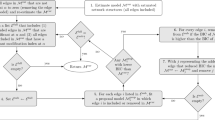Abstract
Exponential smoothing procedures, in particular those recommended byBrown [1962] are used extensively in many areas of economics, business and engineering. It is shown in this paper that:
-
i)
Brown's forecasting procedures are optimal in terms of achieving minimum mean square error forecasts only if the underlying stochastic process is included in a limited subclass of ARIMA (p, d, q) processes. Hence, it is shown what assumptions are made when using these procedures.
-
ii)
The implication of point (i) is that the users ofBrown's procedures tacitly assume that the stochastic processes which occur in the real world are from the particular restricted subclass of ARIMA (p, d, q) processes. No reason can be found why these particular models should occur more frequently than others.
-
iii)
It is further shown that even if a stochastic process which would lead toBrown's model occurred, the actual methods used for making the forecasts are clumsy and much simpler procedures can be employed.
Similar content being viewed by others
References
Bachelier, L.: Theory of Speculation, 1900; reprinted inCootner, P.H. (ed.): The Random Character of Stock Market Prices, Massachusetts, 1964.
Box, G.E.P., andG.M. Jenkins: Time Series Analysis, Forecasting and Control, San Francisco 1970.
Brown, R.G.: Smoothing, Forecasting and Prediction of Discrete Time Series, New Jersey, 1962.
Brown, R.G., andR.F. Meyer: The Fundamental Theorem of Exponential Smoothing, Operations Research9, 1961, 673–685.
Dobbie, J.M.: Forecasting Periodic Trends by Exponential Smoothing, Operations Research11, 1963, 908–918.
Godolphin, E.J., andP.J. Harrison: Equivalence Theorems for Polynomial-projecting Predictors, JRSS, Series B,37, 1975, 205–215.
Holt, C.C.: Forecasting Trends and Seasonals by Exponentially Weighted Moving Averages, O.N.R. Memorandom, No. 52, 1957. Carnegie Institute of Technology.
Kolmogorov, A.: Interpolation und Extrapolation von stationären zufälligen Folgen, Bull. Acad. Sci. (Nauk) U.S.S.R., Ser. Math.5, 1941a, 3–14.
Kolmogorov, A.: Stationary Sequences in Hilbert Space, Bull. Math., University of Moscow2 (6), 1941b.
Muth, G.F.: Optimal Properties of Exponentially Weighted Forecasts of Time Series with Permanent and Transitory Components, JASA55, 1960, 299–306.
Pandit, S.M.: Data Dependent Systems: Modelling, Analysis and Optimal Control via Time Series, Ph.D. thesis, University of Wisconsin, Madison, 1973.
Winters, P.R.: Forecasting Sales by Exponentially Weighted Moving Averages, Management Science6, 1960, 324–342.
Wold, H.O.: A Study in the Analysis of Stationary Time Series, Uppsala (2nd ed. 1954).
Yaglom, A.M.: The Correlation Theory of Processes whosen'th Difference Constitutes a Stationary Process, Matem. Sb.37, 1955, p. 141.
Yule, G.U.: On a method of Investigating Periodicities in Disturbed Series, with Special Reference to Wölfer's Sunspot Numbers, Phil. Trans.226, 1927, p. 267.
Author information
Authors and Affiliations
Rights and permissions
About this article
Cite this article
Ledolter, J., Box, G.E.P. Conditions for the optimality of exponential smoothing forecast procedures. Metrika 25, 77–93 (1978). https://doi.org/10.1007/BF02204353
Received:
Issue Date:
DOI: https://doi.org/10.1007/BF02204353




